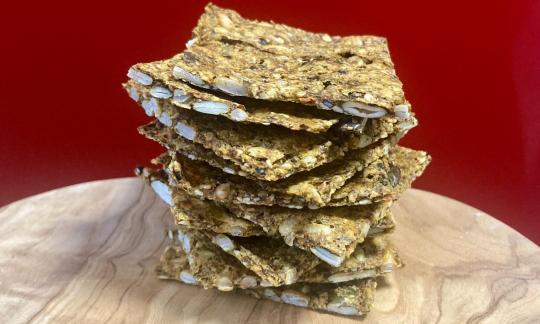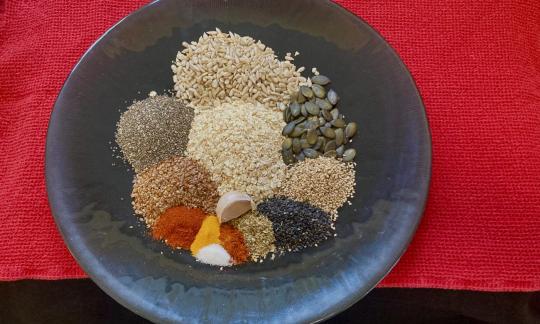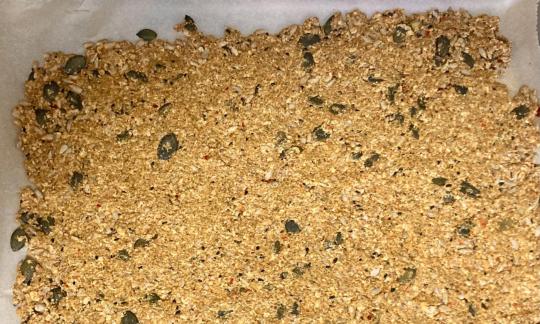multigrain seed crackers
vegan
Ingredients (for servings, )
| For the multigrain seed crackers | |
|---|---|
| 3 tbsp, ground | Chia (chia seeds), raw, organic? (0.61 oz) |
| 2 ⅞ oz | Oat flakes (raw?, organic?) |
| 3 tbsp, ground | Linseed, raw, organic? (golden linseed, flax) (0.74 oz) |
| 1 clove | Garlic (organic?) (0.11 oz) |
| 3 ¾ oz | Sunflower seeds, raw (organic?) |
| 5 tbsp | Pumpkin seeds, dried, raw (organic?) (1.8 oz) |
| 3 tbsp | Sesame, raw, unpeeled (sesame seeds, organic?) (0.95 oz) |
| 1 tbsp | Sesame, black (raw, organic?) (0.32 oz) |
| 2 tbsp | Chia (chia seeds), raw, organic? (0.37 oz) |
| 270 ml | Drinking water, raw (organic?) (9.5 oz) |
| Spices | |
| ½ tsp | Table salt (table salt, raw?, organic?) (0.11 oz) |
| 2 tsp | Herbs of Provence (raw?, organic?) (0.09 oz) |
| 1 ½ tsp | Cayenne pepper (raw?, organic?) (0.09 oz) |
| 1 tbsp | Paprika powder, sweet (raw?, organic?) (0.24 oz) |
| ½ tsp | Turmeric (saffron root), ground, raw (organic?) (0.05 oz) |
Equipment
- garlic press
- rolling pin
- coffee grinder, electric
- oven
- baking sheet (cookie sheet)
Type of preparation
- bake
- chop or grind
- squeeze
- remove the skin
- roll out
Preparation
Preparation
Preheat the oven to 150 °C. Line 2 baking trays with baking paper.
For a portion for 10 people, grind 3 tablespoons of chia seeds with 2 tablespoons of the specified amount of oat flakes in a coffee grinder. Grind the flax seeds completely. Peel and press the garlic.preparation
Mix all the ingredients for the crackers together and spread the mixture very thinly on the baking paper using a spoon or rolling pin. It will take a while until the mixture is spread thinly and evenly.If you like it spicy, use a little more cayenne pepper or add chili.
Finishing the crackers
Put the baking trays in the oven and bake for a total of about 35 minutes. After about 20 minutes, take them out, turn the dough sheets over and cut them into pieces about 5 x 5 cm (or as desired) and bake on the other side for about another 15 minutes. The crackers should get a little brown but not burn.
Then remove from the baking tray and allow to cool.Depending on the oven, it may be useful to bake the trays one after the other.
You can also skip the cutting beforehand and cut or break the crackers into pieces at the very end, but this will result in more uneven pieces.
|
Nutritional Information per person
Convert per 100g
|
2000 kcal | |
|---|---|---|
| Energy | 175 kcal | 8.7% |
| Fat/Lipids | 12 g | 17.7% |
| Saturated Fats | 1.5 g | 7.3% |
| Carbohydrates (inc.dietary fiber) | 12 g | 4.4% |
| Sugars | 0.86 g | 1.0% |
| Fiber | 4.4 g | 17.4% |
| Protein/Albumin | 6.6 g | 13.2% |
| Cooking Salt (Na:121.2 mg) | 308 mg | 12.8% |
| Essential micronutrients with the highest proportions | per person | 2000 kcal | |
|---|---|---|---|
| Min | Manganese, Mn | 1.0 mg | 52.0% |
| Min | Copper, Cu | 0.51 mg | 51.0% |
| Fat | Alpha-Linolenic acid; ALA; 18:3 omega-3 | 1.0 g | 51.0% |
| Fat | Linoleic acid; LA; 18:2 omega-6 | 4.9 g | 49.0% |
| Prot | Tryptophan (Trp, W) | 0.12 g | 47.0% |
| Vit | Vitamin E, as a-TEs | 4.1 mg | 34.0% |
| Elem | Phosphorus, P | 234 mg | 33.0% |
| Elem | Magnesium, Mg | 110 mg | 29.0% |
| Vit | Vitamin B1 (Thiamine) | 0.30 mg | 27.0% |
| Prot | Threonine (Thr, T, irreversibly transaminated) | 0.25 g | 27.0% |
Detailed Nutritional Information per Person for this Recipe
The majority of the nutritional information comes from the USDA (US Department of Agriculture). This means that the information for natural products is often incomplete or only given within broader categories, whereas in most cases products made from these have more complete information displayed.
If we take flaxseed, for example, the important essential amino acid ALA (omega-3) is only included in an overarching category whereas for flaxseed oil ALA is listed specifically. In time, we will be able to change this, but it will require a lot of work. An “i” appears behind ingredients that have been adjusted and an explanation appears when you hover over this symbol.
For Erb Muesli, the original calculations resulted in 48 % of the daily requirement of ALA — but with the correction, we see that the muesli actually covers >100 % of the necessary recommendation for the omega-3 fatty acid ALA. Our goal is to eventually be able to compare the nutritional value of our recipes with those that are used in conventional western lifestyles.
| Essential fatty acids | per person | 2000 kcal |
|---|---|---|
| Alpha-Linolenic acid; ALA; 18:3 omega-3 | 1.0 g | 51.0% |
| Linoleic acid; LA; 18:2 omega-6 | 4.9 g | 49.0% |
| Essential amino acids | per person | 2000 kcal |
|---|---|---|
| Tryptophan (Trp, W) | 0.12 g | 47.0% |
| Threonine (Thr, T, irreversibly transaminated) | 0.25 g | 27.0% |
| Isoleucine (Ile, I) | 0.31 g | 25.0% |
| Phenylalanine (Phe, F) | 0.36 g | 23.0% |
| Valin (Val, V) | 0.38 g | 23.0% |
| Leucine (Leu, L) | 0.51 g | 21.0% |
| Lysine (Lys, K, irreversibly transaminated) | 0.29 g | 16.0% |
| Methionine (Met, M) | 0.15 g | 16.0% |
| Vitamins | per person | 2000 kcal |
|---|---|---|
| Vitamin E, as a-TEs | 4.1 mg | 34.0% |
| Vitamin B1 (Thiamine) | 0.30 mg | 27.0% |
| Vitamin B9, B11 (Folate, as the active form of folic acid) | 38 µg | 19.0% |
| Vitamin B7 (Biotin, ex vitamin H) | 9.5 µg | 19.0% |
| Vitamin B6 (pyridoxine) | 0.22 mg | 15.0% |
| Vitamin B3 (Niacin) | 1.9 mg | 12.0% |
| Vitamin B2 (Riboflavin) | 0.09 mg | 7.0% |
| Vitamin A, as RAE | 47 µg | 6.0% |
| Vitamin B5 (Pantothenic acid) | 0.28 mg | 5.0% |
| Vitamin K | 1.5 µg | 2.0% |
| Vitamin C (ascorbic acid) | 0.67 mg | 1.0% |
| Essential macroelements (macronutrients) | per person | 2000 kcal |
|---|---|---|
| Phosphorus, P | 234 mg | 33.0% |
| Magnesium, Mg | 110 mg | 29.0% |
| Sodium, Na | 121 mg | 15.0% |
| Potassium, K | 215 mg | 11.0% |
| Calcium, Ca | 79 mg | 10.0% |
| Essential trace elements (micronutrients) | per person | 2000 kcal |
|---|---|---|
| Manganese, Mn | 1.0 mg | 52.0% |
| Copper, Cu | 0.51 mg | 51.0% |
| Selenium, Se | 12 µg | 22.0% |
| Iron, Fe | 2.6 mg | 19.0% |
| Zinc, Zn | 1.8 mg | 18.0% |
| Fluorine, F | 23 µg | 1.0% |
| Iod, I (Jod, J) | 1.1 µg | 1.0% |
These very easy to make multigrain seed crackers are not only healthy but also very tasty.
Nutrient profile: With only 175 kcal per 100g, these healthy crackers are very low in calories. According to GDA guidelines, one portion provides around 50% of the essential trace elements manganese and copper. The omega-3 fatty acids are also covered by 50%. The ratio of omega-6 to omega-3 fatty acids is 5:1, which is within the maximum recommended ratio of 5:1.
You can find further information on this topic at the following link: Vegans often eat unhealthily. Avoidable nutritional errors.
Chia seeds: Chia seeds, which come from Mexico, are particularly characterized by their high content of calcium, iron, soluble fiber and omega-3 fatty acids. Our body can benefit from the effects of these substances, especially when eating ground seeds, since the seeds in unground form are mainly used as fiber. The iron content is about twice as high as in grains. Furthermore, the human organism can use the proportion of the amino acid tryptophan to convert it into the messenger substance serotonin via the body's own enzymes. The latter is generally considered to be a mood enhancer by conveying feelings of calm and inner satisfaction. Around 95% of our serotonin content is stored in the gastrointestinal tract!
Flaxseed: Flaxseed has a slightly nutty taste and a fat content of 40%. It contains around 50% of the polyunsaturated omega-3 fatty acid alpha-linolenic acid (ALA), making it the highest concentration of omega-3 fatty acids of all known vegetable oils.
Sunflower seeds: Sunflower seeds contain over 90% unsaturated fatty acids, vitamin E, vitamin B, vitamin A, vitamin F, carotene, calcium, iodine and magnesium.
Pumpkin seeds: The green, flat-oval pumpkin seeds are the seeds of the pumpkin and are available raw or roasted. Roasted pumpkin seeds are rich in unsaturated fatty acids, vitamins and minerals, but contain a very poor ratio of omega-6 (LA) to omega-3 fatty acids (ALA) at 176:1.
Sesame: Sesame originally comes from South Asia, where it has been used for around 5,000 years. The gluten-free seeds of this pseudocereal contain 50% fat, of which 44% are polyunsaturated fatty acids. Sesame seeds are one of the foods richest in selenium. They also contain a large amount of calcium. Anyone who is sensitive to sesame should be careful, as it is a very strong allergen.
Black sesame: Black sesame is considered the original form of sesame. It is particularly rich in valuable nutrients and building materials and has a more intense flavor than white sesame. Sesame is one of the foods richest in selenium and contains a considerable amount of calcium. Allergic people should be careful, as sesame is a strong allergen.
Spices: You can of course also use other spices, such as curry.
Spiciness: If you like it spicy, use a little more cayenne pepper or add chili.








